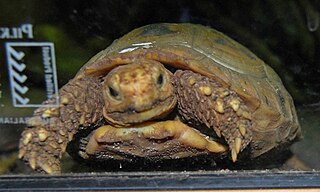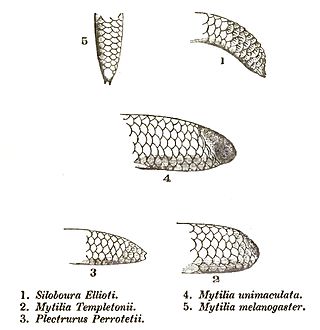
Viperinae, or viperines, are a subfamily of vipers endemic to Europe, Asia and Africa. They are distinguished by their lack of the heat-sensing pit organs that characterize their sister group, the subfamily Crotalinae. Currently, 13 genera are recognized. Most are tropical and subtropical, although one species, Vipera berus, even occurs within the Arctic Circle. Like all vipers, they are venomous.

Edward Blyth was an English zoologist who worked for most of his life in India as a curator of zoology at the Royal Asiatic Society of Bengal in Calcutta.
Theodore Edward (Theodor Edvard)Cantor (1809–1860) was a Danish physician, zoologist and botanist. He described several new species of reptiles and amphibians, and six species have been named in his honor.

Phrynocephalus theobaldi is a species of lizard in the family Agamidae. The species is endemic to Asia.
Trimeresurus cantori, commonly known as Cantor's pit viper or Cantor's pitviper, is a species of venomous snake, a pit viper in the Subfamily Crotalinae of the family Viperidae. The species is endemic to the Nicobar Islands of India. It was named after Theodore Edward Cantor (1809-1860), a Danish naturalist serving as a surgeon with the East India Company in Calcutta. No subspecies are recognized as being valid.

The Himalayan keelback is a species of grass snake in the family Colubridae. The species is endemic to South Asia.

The Sikkim keelback is a species of grass snake in the family Colubridae. The species is endemic to South Asia and Myanmar. It is closely related to the Himalayan keelback, and some treat this species as a synonym.
Blythia reticulata, commonly known as Blyth's reticulate snake, Blyth's reticulated snake, or the iridescent snake, is a species of snake in the subfamily Natricinae of the family Colubridae of the superfamily Colubroidea. The species is endemic to Asia.

Gonyosoma prasinum is a species of colubrid snake found in Asia.
Ptyas nigromarginata, commonly known as the green rat snake or black-bordered rat snake, is a species of snake in the family Colubridae. The species is endemic to Asia.

Cyrtodactylus rubidus is a species of gecko found in the Andaman Islands (India) and the Coco Islands (Myanmar). The type locality is Port Blair, Andaman Islands.

Pseudoxenodon macrops, commonly known as the large-eyed bamboo snake or the big-eyed bamboo snake, is a species of mildly venomous rear-fanged snake endemic to Asia.

Ophisops jerdonii, commonly known as Jerdon's cabrita, Jerdon's snake-eye, and the Punjab snake-eyed lacerta, is a species of lizard in the family Lacertidae. The species is native to South Asia.
Eumeces blythianus, commonly known as Blyth's skink, is a species of lizard in the family Scincidae. The species is native to South Asia.

The Natricinae are a subfamily of colubroid snakes, sometimes referred to as a family (Natricidae). The subfamily comprises 36 genera. Members include many very common snake species, such as the European grass snakes, and the North American water snakes and garter snakes. Some Old World members of the subfamily are known as keelbacks, because their dorsal scales exhibit strong keeling.

Indotestudo is a genus of tortoises in the family Testudinidae. The genus is native to South and Southeast Asia. The three species in the genus are all threatened.

Rhinophis blythii, or Blyth's earth snake, is a species of snake in the family Uropeltidae. The species is endemic to the rain forests and grasslands of Sri Lanka.

Calliophis intestinalis, commonly known as the banded Malayan coral snake, is a species of venomous elapid snake endemic to Southeast Asia.

The fauna of Bangladesh includes about 1,600 species of vertebrate fauna and about 1,000 species of invertebrate fauna based on incomplete records. The vertebrate fauna consists of roughly 22 species of amphibians, 708 species of fish, 126 species of reptiles, 628 species of birds and 113 species of mammals. The invertebrate fauna includes about 30 species of aphids, 20 species of bees, 178 species of beetles, 135 species of flies, 400 species of spiders, 150 species of lepidopterans 52 species of decapods, 30 species of copepods, 2 species of starfish, and some species of sand dollars, sea cucumbers, and sea urchins.

Platyceps is a genus of snakes of the family Colubridae endemic to Eurasia.














